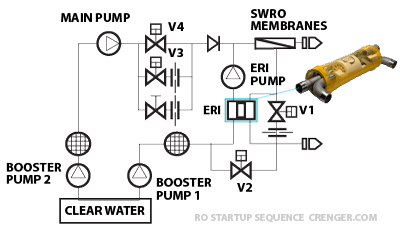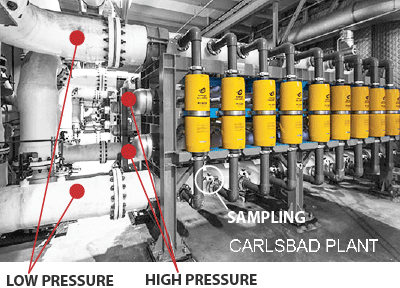
It is a common wisdom that regardless of the desalination plant size the goodness of its design depends on how we solve 2 problems – seawater pretreatment and start-up sequence. The first point is well-researched – googling produces thousands of links. However, the second one somehow has escaped the desalination community's attention. But not of the reverse osmosis membrane manufacturers – all of them link the guaranteed performance to the smoothness of the start-up procedure.
So as not to lose the guarantee, the clients - not the EPC contractors - shall be well educated about possible start-up scenarios. They range from brutal to intelligent. The brutal type may be conditionally accepted for plants with less than 10 – 20 startups per year. If the plant is powered by a renewable source or its load follows the electricity tariffs, then intelligent startup is the only choice.
The ultimate objective of any startup scenario is to maintain the same pressure rise speed of 0.5 Bar/sec on the RO membranes from 0 to 70 Bars. To control the speed two principal approaches exist. The first uses the high-pressure pump variable speed drive (VSD) or soft starter as controller, the second employs the valves. Both approaches have pros and cons and may affect the pretreatment selection.
The lack of the transient performance methodology has made valve-based control a predominant choice even in the biggest desalination plants.
Its basic implementation discussed below may be classified as moderately brutal. It is shown in the diagram above. It includes the tandem of the booster pump 2 and the high-pressure pump separated by the cartridge filter. The energy recovery module includes the low-pressure booster 1, the cartridge filter, the ERI energy recovery devices array, and the ERI pump. The typical arrangement of the ERI devices array is shown in the figure below.

The high-pressure pump motor is started direct-on-line (DOL) as the variable speed drives for capacities above 1200 kW are expensive. As the design discharge pressure of the booster pump 2 depends upon the state of the cartridge filter, fouling of the membranes, and the seawater temperature, it shall be equipped with the variable speed drive. The low-pressure booster pump 1 is also equipped with VSD to accommodate for the pressure loss increase on the cartridge filter. Required by the startup procedure instrumentation includes only 3 valves depicted as V1, V2, and V3 installed in bypass lines. The major steps of the startup procedure are explained in this video.
